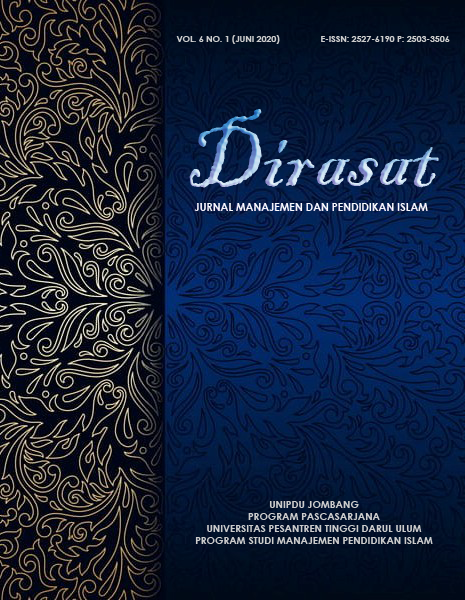Hasil Belajar Siswa Berdasarkan Gaya Belajar Berbeda pada Pembelajaran Daring Mata Pelajaran PAI di Sekolah Dasar
DOI:
https://doi.org/10.26594/dirasat.v8i1.2819Keywords:
Learning styles, student learning outcomes, online learningAbstract
Abstract: Since the entry of Covid-19 into Indonesia, the government has encouraged the public to carry out all activities from home, including teaching and learning activities or study from home (SFH). This situation requires a teacher to be able to design a learning strategy using various online learning media that can support the student learning process, because the right learning media and in accordance with the student's learning style will make it easier for students to achieve their learning targets. This study aims to determine the learning styles and student learning outcomes as well as the influence of learning styles on student learning outcomes in Islamic Education subject class 4-F at Al-Hikmah Elementary School Surabaya. After doing the analysis using Linear Regression Test, this study shows that learning style has a significant influence on student learning outcomes. The results of this study showed that 77% or 23 students had a visual learning style and 23% or 7 students had an auditory learing style and there were no students with a kinestethic learning style. Thus the Islamic Religious Education teachers can teach according to students learning styles, because the learnig process that pays attentions to students learning styles will have a greater influence in improving student learning outcomes in Islamic Religious Education subject.
References
Efendi, Ahmad Farid. “Strategi Guru Pendidikan Agama Islam dalam Menghadapi Gaya Belajar Siswa di SMP Islam Sabilurrosyad Malang.” (Skripsi, Studi Pendidikan Agama Islam, Fakultas Ilmu Tarbiyah dan Keguruan, UIN Malik Ibrahim Malang, 2016): 2.
Handarini, Oktafia Ika, dan Siti Sri Wulandari. “Pembelajaran Daring sebagai Upaya Study from Home (SFH) Selama Pandemi Covid 19.” Jurnal Pendidikan Administrasi Perkantoran (JPAP) 8, no. 3 (2020): 496.
Isradini, Nadya, dkk. “Peran Teknologi Informasi dan Komunikasi pada Pembelajaran Daring di Masa Pandemi Covid-19.” Jurnal Persada 3, no. 3 (Desember, 2020): 178.
Mohd, Fatihah, et. al. “An Architecture of Decision Support System for Visual-Auditory-Kinesthetic (VAK) Learning Styles Detection Through Behavioral Modelling.” International Journal of Innovation in Enterprise System 3, no. 1 (2019): 24.
Mokodompit, Intan Safitri. “Home Visit sebagai Refleksi Kurikulum Darurat Covid-19: Kesiapan Guru, Respon Siswa, Materi dan Hasil Belajar di Madrasah Tsanawiyah.” Dirasat: Jurnal Manajemen dan Pendidikan Islam 6, no. 2 (Desember, 2020): 121.
Papilaya, Jeanete Ophilia, dan Neleke Huliselan, "Identifikasi Gaya Belajar Mahasiswa.” Jurnal Psikologi Undip 15, no. 1 (April, 2016): 58.
Pratiwi, Desti, dkk. “Gaya Belajar Dominan pada Siswa Berprestasi dalam Kegiatan Pembelajaran di SD Negeri 2 Gombong Tahun Ajaran 2013/2014.” Jurnal FKIP 7, no. 3 (2014): 1.
Rahimii, Shoeib, et. al. “Learning Styles in University Education (Systematic Review).” Indian Journal of Public Health Research & Development 8, no. 2 (April-June): 390.
Rayuwati, Rayuwati. “How Educational Technology Innovates Distance Learning during Pandemic Crisis in Remote Areas in Indonesia?.” International research journal of management, IT and social sciences 7, no. 6 (2020): 161.
Rusydiyah, Evi Fatimatur. Teknologi Pembelajaran: Implementasi Pembelajaran Era 4.0. Surabaya: UIN Sunan Ampel Press, 2019.
Salsabila, Unik Hanifah, dkk. “Pemanfaatan Teknologi Media Pembelajaran di Masa Pandemi Covid-19.” Trapsila: Jurnal Pendidikan Dasar 2, no. 2 (Desember, 2020): 2.
Salsabila, Unik Hanifah, dkk. “Peran Teknologi dalam Pembelajaran di Masa Pandemi Covid-19.” Al-Mutharahah: Jurnal Penelitian dan Kajian Sosial Keagamaan 17, no. 2 (Juli-Desember, 2020): 189.
Sanusi, Hary Priatna. “Peran Guru PAI Dalam Pengembangan Nuansa Religius di Sekolah.” Jurnal Pendidikan Agama Islam-Ta’lim 11, no. 2 (2013): 148.
Sari, Ariesta Kartika. “Analisis Karakteristik Gaya Belajar Vak (Visual, Auditorial, Kinestetik) Mahasiswa Pendidikan Informatika Angkatan 2014.” Edutic-Scientific Journal of Informatics Education 1, no. 1 (November, 2014): 8.
Sari, Siti Rafiqa, dkk. “Pengaruh Gaya Belajar Siswa terhadap Hasil Belajar Pendidikan Agama Islam Pengaruh Gaya Belajar Siswa terhadap Hasil Belajar Pendidikan Agama Islam.” IQRO: Journal of Islamic Education 2, no. 2 (Desember, 2019): 117.
Setiyowati, Asih, dkk. “Peran Teknologi Pendidikan dalam Penggunaan E-Learning sebagai Platform Pembelajaran di Masa Pandemi Covid-19.” Edureligia: Jurnal Pendidikan Agama Islam 4, no. 2 (Juli-Desember, 2020): 203.
Suyono, Akhmad. “Pengaruh Gaya Belajar terhadap Hasil Belajar pada Mata Pelajaran Akuntansi Kelas XI IPS SMAN 3 Tapung,” PeKA: Jurnal Pendidikan Ekonomi Akuntansi FKIP UIR 6, no. 1 (2018): 3.
Suyono, Akhmad. “Pengaruh Gaya Belajar terhadap Hasil Belajar pada Mata Pelajaran Akuntansi Kelas XI IPS SMAN 3 Tapung Tahun Ajaran 2017/2018.” PeKA: Jurnal Pendidikan Ekonomi Akuntansi FKIP UIR 6, no. 1 (2018): 7.
Syahrum, Syahrum, dan Salim Salim. Metodologi Penelitian Kuantitatif. Bandung: Citapustaka Media, 2014.
Undang-Undang RI Nomor 20 Tahun 2003 tentang Sistem Pendidikan Nasional.
Yaumi, Muhammad. Media dan Teknologi Pembelajaran. Jakarta: Prenadamedia Group, 2018.
Downloads
- PDF (Bahasa Indonesia)

